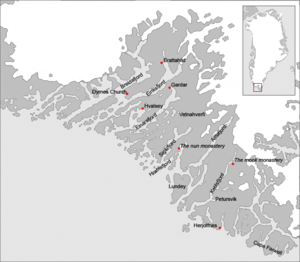Eastern Settlement facts for kids
The Eastern Settlement was the first and largest area where Norse people (often called Vikings) from Iceland settled in Greenland. They started living there around the years 985 to 1000 AD. At its busiest time, about 4,000 people lived in this settlement. We know they were still there in 1408 because a wedding was recorded in a place called Hvalsey. This means they stayed for about 50 to 100 years longer than the people in the more northern Western Settlement.
Contents
Where Was It Located?
Even though it was called the "Eastern Settlement," it was actually more to the south than east of the other Norse settlements. Like the Western Settlement, it was located on the southwestern tip of Greenland. The settlers chose areas at the end of long, narrow inlets of the sea called fjords. Some important fjords were Tunulliarfik Fjord, Igaliku (also known as Einarsfjord), and Sermilik Fjord.
Archaeologists have found about 500 groups of ruins from Norse farms in this area. There are also 16 church ruins. Famous places include Brattahlíð, Dyrnæs, Garðar, Hvalsey, and Herjolfsnes. A district called Vatnahverfi, southeast of Einarsfjord, had some of the best land for farming. About 10% of all known farm sites in the Eastern Settlement were found there.
How Did They Live?
The Norse settlers in medieval Greenland mostly made a living by raising animals. They had many sheep and cattle. They also hunted seals for food and other resources.
During the 14th century, the weather became colder. This period is known as the Little Ice Age. This colder weather likely made it harder to grow enough hay to feed their animals in winter. It also probably made their hay fields less productive.
Scientists have studied bones found at the old Norse settlements. They use a method called isotope analysis to learn about what people ate. These studies show that fishing became more and more important for the settlers as time went on. At first, the early settlers ate mostly farm products (about 80%) and some food from the sea (about 20%). But by the 14th century, the Norse people in Greenland got most of their food (50-80%) from the sea.
What Happened to the Settlers?
The Greenlandic Inuit people have an old story about why the Norse people of Hvalsey disappeared and why their homes and churches are now ruins. This legend tells of a fight between a Norse leader named Ungortoq and a young Inuit warrior named K'aissape.
The story says that Ungortoq had killed K'aissape's younger brother. To get revenge, Inuit warriors led by K'aissape came to Hvalsey by sea. They were disguised to look like an iceberg. Then, they burned the Norse settlers inside their houses. However, Ungortoq and his family managed to escape. K'aissape then chased them down and killed Ungortoq and his whole family near Cape Farewell.
Archaeological studies, which involve digging up and studying old sites, have not found any signs of a big fire at Hvalsey. So, this story might be a legend rather than a historical event. Other ideas about why the settlements ended include problems with the land, like soil erosion from too much grazing by animals. The terrible disease known as the Black Death might also have played a part, though it's not clear how much it affected Greenland.
World Heritage Site
Many important parts of the Eastern Settlement are now protected. This includes Brattahlíð, which was the home of Erik the Red, the famous Viking who founded the first Norse settlement in Greenland. In 2017, these areas were added to the UNESCO World Heritage List. They are now known as Kujataa Greenland: Norse and Inuit Farming at the Edge of the Ice Cap. This recognizes their special history and importance.
See also
 In Spanish: Asentamiento Oriental para niños
In Spanish: Asentamiento Oriental para niños


